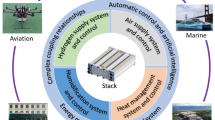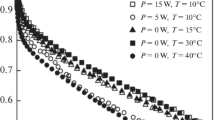Abstract
Thermal management is considered a critical issue in proton exchange membrane fuel cells (PEMFCs), since it not only influences the cell performance but also impacts PEMFC’s reliability and durability. With the ever-increasing power density of PEMFC, traditional cooling approaches including air cooling and water cooling become difficult to meet the demand for high-power heat dissipation. Therefore, phase-change cooling is proposed for fuel cell application in this work, and the potential advantages are discussed and demonstrated via a mathematical model incorporating phase-change heat transfer. The thermal management performance is evaluated by temperature uniformity, maximum temperature difference, and the cooling capacity to compare the difference between phase-change cooling and traditional methods, which demonstrates that phase-change cooling owns a greatly improved thermal management performance. In addition, a simple method to broaden the operating temperature of phase-change cooling based on one certain coolant is offered, which is pressurizing in the coolant channel to regulate the boiling temperature that could further improve the application feasibility of phase-change cooling strategy in fuel cells.
Similar content being viewed by others
References
Yang Y, Gao X Q, Song W, et al. Altering membrane structure to enhance water permeability and performance of anion exchange membrane fuel cell. Sci China Tech Sci, 2021, 64: 414–122
Wu Y N, Liao S J, Wang K N, et al. High pressure organic colloid method for the preparation of high performance carbon nanotube-supported Pt and PtRu catalysts for fuel cell applications. Sci China Tech Sci, 2010, 53: 264–271
Yan X, Lin C, Zheng Z, et al. Effect of clamping pressure on liquid-cooled PEMFC stack performance considering inhomogeneous gas diffusion layer compression. Appl Energy, 2020, 258: 114073
Zhao J, Jian Q, Huang Z. Experimental study on heat transfer performance of vapor chambers with potential applications in thermal management of proton exchange membrane fuel cells. Appl Thermal Eng, 2020, 180: 115847
Lin L, Zhang X X, Feng H T, et al. Optimization of a serpentine flow field with variable channel heights and widths for PEM fuel cells. Sci China Tech Sci, 2010, 53: 453–460
Liu Y, Tu Z, Chan S H. Applications of ejectors in proton exchange membrane fuel cells: A review. Fuel Process Tech, 2021, 214: 106683
Yan X, Li X, Fu C, et al. Large specific surface area S-doped Fe-N-C electrocatalysts derived from metal-organic frameworks for oxygen reduction reaction. Prog Nat Sci-Mater Int, 2020, 30: 896–904
Yue L, Wang S, Araki T, et al. Effect of water distribution in gas diffusion layer on proton exchange membrane fuel cell performance. Int J Hydrogen Energy, 2021, 46: 2969–2977
Chen H, Guo H, Ye F, et al. An experimental study of cell performance and pressure drop of proton exchange membrane fuel cells with baffled flow channels. J Power Sources, 2020, 472: 228456
Lu X, Kanghong D, Guo L, et al. Optimal estimation of the proton exchange membrane fuel cell model parameters based on extended version of crow search algorithm. J Cleaner Production, 2020, 272: 122640
Zhao J, Huang Z, Jian B, et al. Thermal performance enhancement of air-cooled proton exchange membrane fuel cells by vapor chambers. Energy Convers Manage, 2020, 213: 112830
Peng Y, Yan X, Lin C, et al. Effects of flow field on thermal management in proton exchange membrane fuel cell stacks: A numerical study. Int J Energy Res, 2021, 45: 7617–7630
Chen L, Lin R, Tang S, et al. Structural design of gas diffusion layer for proton exchange membrane fuel cell at varying humidification. J Power Sources, 2020, 467: 228355
Luo L, Huang B, Cheng Z, et al. Improved water management by alternating air flow directions in a proton exchange membrane fuel cell stack. J Power Sources, 2020, 466: 228311
Li W Z, Yang W W, Wang N, et al. Optimization of blocked channel design for a proton exchange membrane fuel cell by coupled genetic algorithm and three-dimensional CFD modeling. Int J Hydrogen Energy, 2020, 45: 17759–17770
Chen C Y, Su J H, Ali H M, et al. Effect of channel structure on the performance of a planar membrane humidifier for proton exchange membrane fuel cell. Int J Heat Mass Transfer, 2020, 163: 120522
Bao Z, Niu Z, Jiao K. Gas distribution and droplet removal of metal foam flow field for proton exchange membrane fuel cells. Appl Energy, 2020, 280: 116011
Wang X, Qin Y, Wu S, et al. Numerical and experimental investigation of baffle plate arrangement on proton exchange membrane fuel cell performance. J Power Sources, 2020, 457: 228034
Luo L, Huang B, Bai X, et al. Temperature uniformity improvement of a proton exchange membrane fuel cell stack with ultra-thin vapor chambers. Appl Energy, 2020, 270: 115192
Ju H, Meng H, Wang C Y. A single-phase, non-isothermal model for PEM fuel cells. Int J Heat Mass Transfer, 2005, 48: 1303–1315
Ravishankar S, Arul Prakash K. Numerical studies on thermal performance of novel cooling plate designs in polymer electrolyte membrane fuel cell stacks. Appl Thermal Eng, 2014, 66: 239–251
Mahjoubi C, Olivier J C, Skander-mustapha S, et al. An improved thermal control of open cathode proton exchange membrane fuel cell. Int J Hydrogen Energy, 2019, 44: 11332–11345
Zhang G, Jiao K. Multi-phase models for water and thermal management of proton exchange membrane fuel cell: A review. J Power Sources, 2018, 391: 120–133
Yuan W W, Ou K, Kim Y B. Thermal management for an air coolant system of a proton exchange membrane fuel cell using heat distribution optimization. Appl Thermal Eng, 2020, 167: 114715
Lee J, Gundu M H, Lee N, et al. Innovative cathode flow-field design for passive air-cooled polymer electrolyte membrane (PEM) fuel cell stacks. Int J Hydrogen Energy, 2020, 45: 11704–11713
Saygili Y, Eroglu I, Kincal S. Model based temperature controller development for water cooled PEM fuel cell systems. Int J Hydrogen Energy, 2015, 40: 615–622
Pei H, Shen J, Cai Y, et al. Operation characteristics of air-cooled proton exchange membrane fuel cell stacks under ambient pressure. Appl Thermal Eng, 2014, 63: 227–233
Zhao X, Li Y, Liu Z, et al. Thermal management system modeling of a water-cooled proton exchange membrane fuel cell. Int J Hydrogen Energy, 2015, 40: 3048–3056
Ramezanizadeh M, Nazari M A, Ahmadi M H, et al. A review on the approaches applied for cooling fuel cells. Int J Heat Mass Transfer, 2019, 139: 517–525
Zhang G, Yuan H, Wang Y, et al. Three-dimensional simulation of a new cooling strategy for proton exchange membrane fuel cell stack using a non-isothermal multiphase model. Appl Energy, 2019, 255: 113865
Tetuko A P, Shabani B, Andrews J. Thermal coupling of PEM fuel cell and metal hydride hydrogen storage using heat pipes. Int J Hydrogen Energy, 2016, 41: 4264–4277
Mayyas A R, Ramani D, Kannan A M, et al. Cooling strategy for effective automotive power trains: 3D thermal modeling and multi-faceted approach for integrating thermoelectric modules into proton exchange membrane fuel cell stack. Int J Hydrogen Energy, 2014, 39: 17327–17335
Soupremanien U, Le Person S, Favre-Marinet M, et al. Tools for designing the cooling system of a proton exchange membrane fuel cell. Appl Thermal Eng, 2012, 40: 161–173
Alizadeh E, Rahgoshay S M, Rahimi-Esbo M, et al. A novel cooling flow field design for polymer electrolyte membrane fuel cell stack. Int J Hydrogen Energy, 2016, 41: 8525–8532
Afshari E, Ziaei-Rad M, Dehkordi M M. Numerical investigation on a novel zigzag-shaped flow channel design for cooling plates of PEM fuel cells. J Energy Institute, 2017, 90: 752–763
Yan W M, Zeng M S, Yang T F, et al. Performance improvement of air-breathing proton exchange membrane fuel cell stacks by thermal management. Int J Hydrogen Energy, 2020, 45: 22324–22339
Odabaee M, Mancin S, Hooman K. Metal foam heat exchangers for thermal management of fuel cell systems—An experimental study. Exp Thermal Fluid Sci, 2013, 51: 214–219
Zakaria I, Mohamed W A N W, Azmi W H, et al. Thermo-electrical performance of PEM fuel cell using Al2O3 nanofluids. Int J Heat Mass Transfer, 2018, 119: 460–471
Islam M R, Shabani B, Rosengarten G. Electrical and thermal conductivities of 50/50 water-ethylene glycol based TiO2 nanofluids to be used as coolants in PEM fuel cells. Energy Procedia, 2017, 110: 101–108
Author information
Authors and Affiliations
Corresponding author
Additional information
This work was supported by the National Key Research and Development Program of China (Grant No. 2016YFB0101312) and the National Natural Science Foundation of China (Grant No. 21706158).
Rights and permissions
About this article
Cite this article
Yan, X., Peng, Y., Shen, Y. et al. The use of phase-change cooling strategy in proton exchange membrane fuel cells: A numerical study. Sci. China Technol. Sci. 64, 2762–2770 (2021). https://doi.org/10.1007/s11431-021-1889-4
Received:
Accepted:
Published:
Issue Date:
DOI: https://doi.org/10.1007/s11431-021-1889-4




